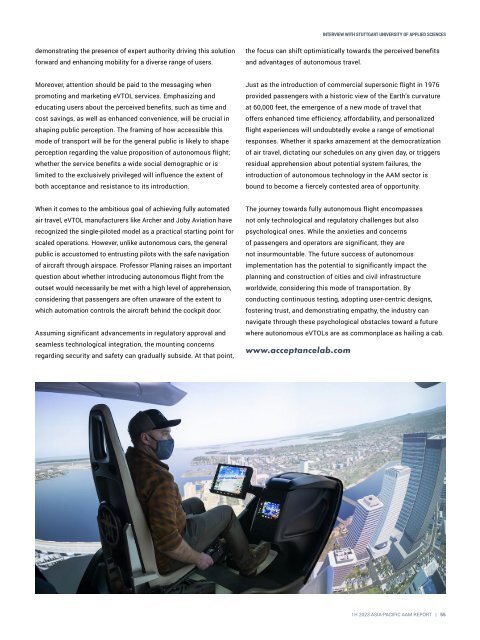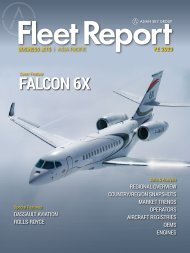Asia-Pacific AAM Report 1H 2023
Create successful ePaper yourself
Turn your PDF publications into a flip-book with our unique Google optimized e-Paper software.
INTERVIEW WITH STUTTGART UNIVERSITY OF APPLIED SCIENCES<br />
demonstrating the presence of expert authority driving this solution<br />
forward and enhancing mobility for a diverse range of users.<br />
the focus can shift optimistically towards the perceived benefits<br />
and advantages of autonomous travel.<br />
Moreover, attention should be paid to the messaging when<br />
promoting and marketing eVTOL services. Emphasizing and<br />
educating users about the perceived benefits, such as time and<br />
cost savings, as well as enhanced convenience, will be crucial in<br />
shaping public perception. The framing of how accessible this<br />
mode of transport will be for the general public is likely to shape<br />
perception regarding the value proposition of autonomous flight;<br />
whether the service benefits a wide social demographic or is<br />
limited to the exclusively privileged will influence the extent of<br />
both acceptance and resistance to its introduction.<br />
Just as the introduction of commercial supersonic flight in 1976<br />
provided passengers with a historic view of the Earth's curvature<br />
at 60,000 feet, the emergence of a new mode of travel that<br />
offers enhanced time efficiency, affordability, and personalized<br />
flight experiences will undoubtedly evoke a range of emotional<br />
responses. Whether it sparks amazement at the democratization<br />
of air travel, dictating our schedules on any given day, or triggers<br />
residual apprehension about potential system failures, the<br />
introduction of autonomous technology in the <strong>AAM</strong> sector is<br />
bound to become a fiercely contested area of opportunity.<br />
When it comes to the ambitious goal of achieving fully automated<br />
air travel, eVTOL manufacturers like Archer and Joby Aviation have<br />
recognized the single-piloted model as a practical starting point for<br />
scaled operations. However, unlike autonomous cars, the general<br />
public is accustomed to entrusting pilots with the safe navigation<br />
of aircraft through airspace. Professor Planing raises an important<br />
question about whether introducing autonomous flight from the<br />
outset would necessarily be met with a high level of apprehension,<br />
considering that passengers are often unaware of the extent to<br />
which automation controls the aircraft behind the cockpit door.<br />
Assuming significant advancements in regulatory approval and<br />
seamless technological integration, the mounting concerns<br />
regarding security and safety can gradually subside. At that point,<br />
The journey towards fully autonomous flight encompasses<br />
not only technological and regulatory challenges but also<br />
psychological ones. While the anxieties and concerns<br />
of passengers and operators are significant, they are<br />
not insurmountable. The future success of autonomous<br />
implementation has the potential to significantly impact the<br />
planning and construction of cities and civil infrastructure<br />
worldwide, considering this mode of transportation. By<br />
conducting continuous testing, adopting user-centric designs,<br />
fostering trust, and demonstrating empathy, the industry can<br />
navigate through these psychological obstacles toward a future<br />
where autonomous eVTOLs are as commonplace as hailing a cab.<br />
www.acceptancelab.com<br />
<strong>1H</strong> <strong>2023</strong> ASIA-PACIFIC <strong>AAM</strong> REPORT | 55
















